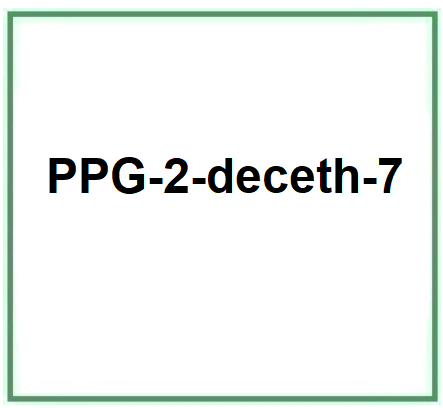PPG-2-deceth-7 is a chemical compound, polypropylene glycol (PPG) ether of decyl alcohol, ethoxylated containing an average of 7 mol of ethylene oxide and 2 mol of propylene oxide.
The name describes the structure of the molecule:
- "PPG" stands for "Polypropylene Glycol", indicating a series of propylene glycol polymers.
- "2-deceth-7" indicates the chemical structure of the ether, where "deceth" refers to a decyl chain and "7" indicates the average number of propylene oxide units in the polymer.
Description of raw materials used in production and their functions.
- Propylene oxide (PO) is the monomer used to form the polypropylene glycol polymer.
- Deceth-7. Fatty alcohol used as an initiator in the production to determine the chain length of the ether.
Step-by-step summary of industrial chemical synthesis process.
- Production of Polypropylene Glycol (PPG). The propylene oxide is polymerized to form polypropylene glycol through an open-chain polymerization reaction.
- Reaction with Deceth-7. The PPG is then made to react with Deceth-7 through an esterification reaction or a similar reaction to form the desired compound, PPG-2-deceth-7.
- Purification. Any impurities or by-products formed during the reaction are removed through various purification processes.
It appears as a colorless liquid.

What it is used for and where
Cosmetics
Surfactant - Emulsifying agent. Emulsions are thermodynamically unstable and are used to soothe or soften the skin and emulsify, so they need a specific, stabilising ingredient. This ingredient forms a film, lowers the surface tension and makes two immiscible liquids miscible. A very important factor affecting the stability of the emulsion is the amount of the emulsifying agent. Emulsifiers have the property of reducing the oil/water or water/oil interfacial tension, improving the stability of the emulsion and also directly influencing the stability, sensory properties and surface tension of sunscreens by modulating the filmometric performance.
Surfactant - Cleansing agent. Cosmetic products used to cleanse the skin utilise the surface-active action that produces a lowering of the surface tension of the stratum corneum, facilitating the removal of dirt and impurities.
Safety
The term 'eth' refers to the ethoxylation reaction with ethylene oxide after which residues of ethylene oxide and 1,4-dioxane, chemical compounds considered carcinogenic, may remain. The degree of safety therefore depends on the degree of purity of the compound obtained. At present, no manufacturer is known to provide this information on the label.
PPG (Polypropylene glycol) in small quantities is a safe, biocompatible, biodegradable polymer that produces pyruvic acid, a metabolite that our body uses to produce metabolic energy.
(CAS 37251-67-5)
Commercial Applications
Cosmetics and Personal Care. PPG-2-deceth-7 is often used as an emulsifying or solubilizing agent in products like lotions, creams, hair care products, and makeup items.
Cleansers and Soaps. Due to its solubilizing properties, it might be found in cleansers and soaps to help mix water-insoluble ingredients.
![]() PPG-2-deceth-7
PPG-2-deceth-7 


